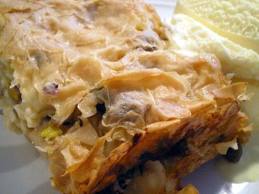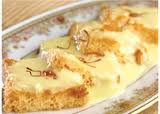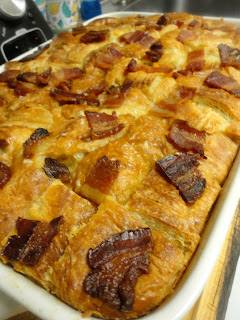Recipe for Butternut Squash and Bacon Bread Pudding
Serves 12 – 16
8 day old croissants
1 4-5 lb. Butternut Squash
Olive Oil
4 cups Half-n-Half
6 egg yolks
¾ cup brown sugar
1 tsbp. Pure Vanilla Extract
8 pieces of thick cut bacon
Caramel Sauce (Store Bought)
Pre-heat oven to 375 degrees.
Cut the Squash in half and remove the seeds. Coat the squash halves with Olive Oil and lay them cut side down on a sheet pan. Put the sheet pan in the oven and cook for 45 minutes.
Remove the squash from the oven and, when cool enough to handle, scoop or cut the flesh out into a bowl.
While the squash cools, raise the temperature of the oven to 425 degrees. Cover the bottom of a sheet pan with aluminum foil. Then place a baking wrack over the foil and put the bacon onto the rack.
Bake in the oven for 12 -15 minutes. Remove bacon to a paper towel covered plate to drain. Cut bacon into 1 inch squares. Set aside.
Butter a 9 x 12 inch baking dish and cut the croissants into 1 inch pieces avoiding compressing them as you do. You want nice fluffy pieces of croissant. Put a layer of croissant pieces in the bottom of the baking dish.
Now take your squash and put a layer of it over croissant layer. Top this with a layer of bacon pieces.
Take the remaining croissant pieces and top the squash with them. Then take the remaining bacon pieces and put a layer of them over the top.
Pre-heat the oven to 350 degrees.
In a bowl, combine the brown sugar, the Vanilla and the egg yolks and whisk until the mixture is a pale gold color. Whisk in the Half’n’Half.
Pour the custard mixture over the bread pudding. Cover the bread pudding with foil and bake for 60 minutes or until a toothpick comes out clean. Remove the foil and crisp the top for another 10 minutes. Heat the Caramel Sauce in the microwave when ready to serve.
Now here’s a point that’s up for discussion in our house. Andrew loved the bread pudding slightly warm, or close to room temperature. (In reality the hot caramel sauce had actually heated the pudding above room temperature.) The California instructions suggested cooling the pudding completely- even refrigerating it—before serving. Late at night, after I’d put the pudding into the fridge, I took a cold piece out, covered it with Hot Caramel Sauce and I thought it was better than ever. Next day, I served in that way to Andrew. He still thought the room temperature version was better. You can decide for yourself.








